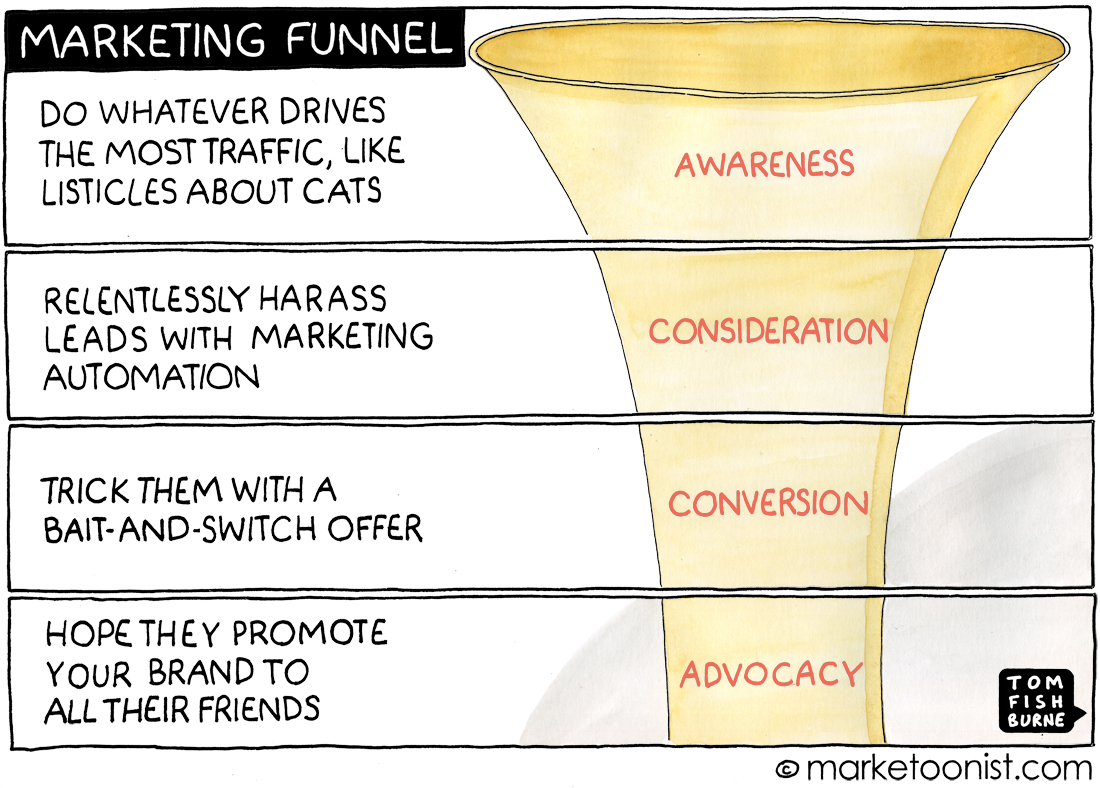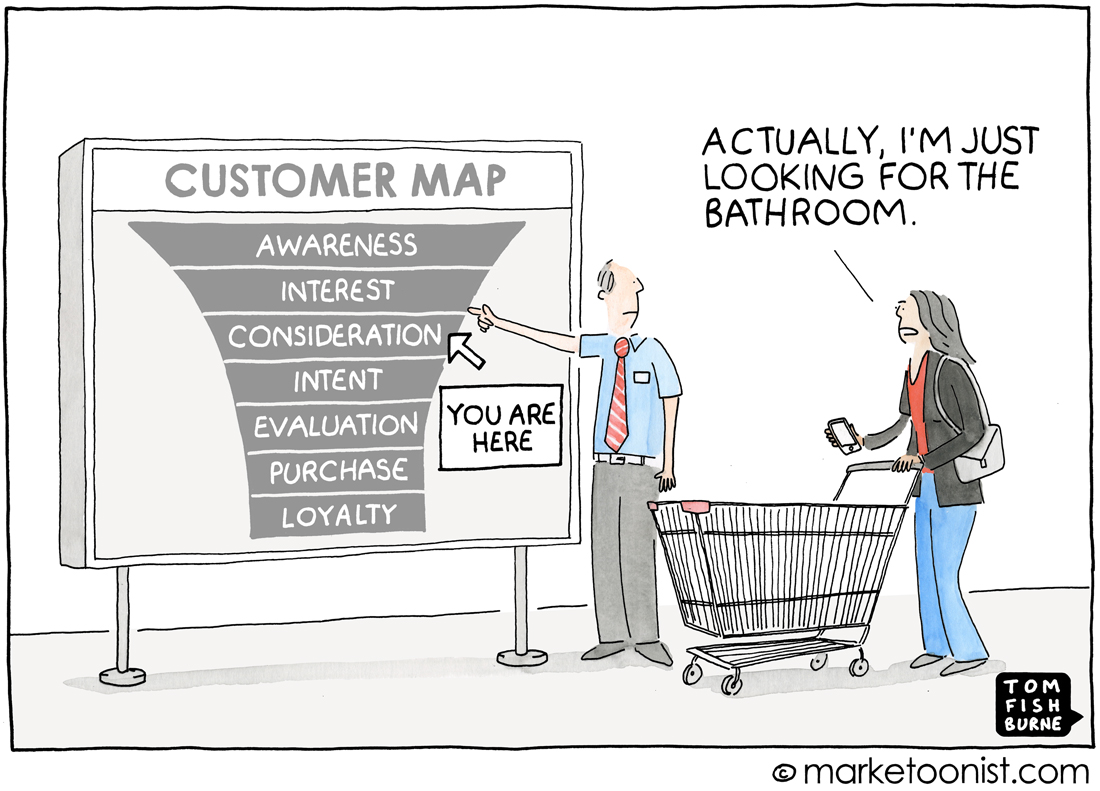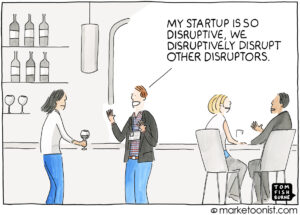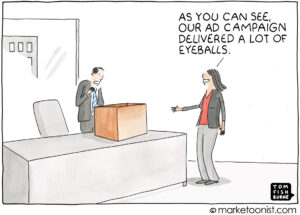Many marketers were schooled in the marketing funnel. In the traditional funnel, consumers move lockstep in uniform sequential stages from awareness to purchase. The specific stages might vary, but the journey is assumed to stay pretty much the same.
The marketing funnel actually dates back to 1898, in the writings of Philadelphia advertising pioneer E. St. Elmo Lewis. His framework was sometimes called the AIDA-model (Awareness, Interest, Desire, Action). Lewis’ marketing funnel is literally a 19th century concept that is still foisted onto today’s digital, social, omnichannel, mobile world. No wonder it’s showing its age.
The marketing funnel can give marketers funnel-vision. In focusing on the transaction over the relationship, marketers can lose sight of the actual consumer the funnel was designed to reach. Mailchimp founder Ben Chestnut described the traditional marketing funnel as a meat grinder.
I found an interesting HBR article, “Marketing can no longer rely on the funnel,” which breaks down some of the ways that the marketing funnel falls short:
“The primary problem with the funnel is that the buying process is no longer linear. Prospects don’t just enter at the top of the funnel; instead, they come in at any stage. Furthermore, they often jump stages, stay in a stage indefinitely, or move back and forth between them.”
The HBR article charts how the funnel has been discarded in favor of different types of customer journey maps developed by Google, Intuit, Sephora, SAP, Twitter, and Visa.
“Whatever model you choose, what’s most important is that it addresses: first, the multi-dimensional nature of social influence; second, non-linear paths to purchase; third, the role of advocates who aren’t customers; and fourth, the shift to ongoing relationships beyond individual transactions.”
Even the act of creating a customer journey map for your organization can shift the mindset of an organization around the needs of the actual customer rather than what will lead quickest to a transaction.
I’d love to hear your thoughts on mapping the customer journey.
Here’s a cartoon I drew about the marketing funnel last year:




Dean Fox says
Your analysis is correct, consumers may enter the funnel at any level, depending on their immediate motivation. If the washer suddenly dies, or a tree falls directly on the car, the consumer is already at the intent level. Given the urgency of their need, they will move in both directions simultaneously, researching the available choices online, while filtering the results with any previous experiences with the brand, recommendations from others and local availability and pricing of the product.
John says
Nice job communicating a key marketplace reality today.
john says
Love this and have been doing a lot of research in the area. In short, the customer journey is in fact still linear, because we complete tasks in chronological order. However, our perception of a standard path that fits most customers is a figment of imagination. We write specifically on the journey here: http://www.magnipath.com/blog. Interested to hear your thoughts!
Andy says
While I completely agree with your post and indeed the customer journey is no longer linear and consumers can enter in at any point, I still think that best thing about the ‘funnel’ is that it makes marketers think about what they need to do at each stage. Not everyone knows about your brand, not everyone is considering it and so on. It’s simple enough for everyone in an organization to understand what role they can play in the process and that’s really important too.
It’s also great because its measurable. We might have a great product that converts exceptionally well, but has poor awareness. Or we might have a product that everyone knows about (or thinks they know about – depth of awareness is a different thing altogether), but no one is interested in trying. The right strategy for these two products would be very different.
Anyway, really enjoy the marketoons. Keep up the good work Tom
ST says
The funnel was never sequential. And it hasn’t changed one bit. The mechanisms and tools for customers have evolved. As they always have been, but the funnel was and is as relevant as always.
Sonam says
In today’s always-on digital environment, customer engagement no longer functions like a funnel managed by the brand. We propose a new framework, the Customer Engagement Engine, where customers synergistically interact with each other.
For more information on the Customer Engagement Engine visit:
http://spiegel.medill.northwestern.edu/consumer-engagement-engine/
@SpiegelResearch
Jules says
I like the funnel. I head up a pretty large multi functional / discipline marketing team who tend to focus just on their own metrics, which is more often that not, just the ‘sale’. In fact, the entire business is purely sales focused, so I use the funnel to help illustrate the different metrics we can look at to understand prospect engagement at different points (e.g. dwell time and visits to our website, or overall brand awareness after a TV campaign). Since I focused my teams on the funnel and their role in it, I’ve seen a strong increase in overall performance and more collaboration, as well as acceptance that the high CPA after a TV campaign is OK if it’s driving interactions further down the funnel. I agree the funnel isn’t the be-all-and-end-all but it can serve a purpose and has certainly helped me.
Ammon Johns says
The problem here is that there are two funnels, both referred to as funnels, yet actually separate and distinct things.
There is the conceptual, model funnel, which says that people have to be aware of a thing before they can be interested in it, that they must be interested in it before they can desire it, and that they must desire an outcome before they will act to attain it.
I promise you that nobody leaps into the funnel at desire for something they are unaware of and have no interest in.
However, where many marketers talk about the funnel, they don’t mean the abstract model, but their own implementation. The function that they have placed out there for people at the ‘desire’ stage, not the actual fact that people will need to desire it before they act.
There is some ability to go back up the funnel. We can lose interest in things that we were interested in, and go back to mere awareness. We can find that our interest doesn’t develop further into desire. But we still do not leap from awareness straight to action, nor do we begin fully fledged at action without all the prior steps being taken.
The funnel is called a funnel because it gets smaller. Less people make it down to the next step than arrived at the current one. Only a proportion of all those aware of our offer will be interested in it, and only a proportion of those interested will actually desire it, and of those who desire it, only a proportion will take action on that desire.
You don’t ever get more people taking an interest than were aware there was a thing to get interested in. Its a funnel shape.
The meat grinder often does have a funnel. But it also has pressure applied from above. The funnel is both loaded from outside the funnel, and is subject to pressure from outside the funnel. Your own funnel probably won’t have that, barring some kind of divine intervention, or perhaps some new legislation forcing people to purchase the thing. The meat grinder then is more how people would choose to think about the inhumanity of a rigid funnel for customers, than about the fact its just describing the shape of the diagram.
Ram says
Customers now are well informed and they decide even before salesman comes to know about their requirements. Firstly understand customers buying pattern and take it forward. …
Joel Ehrlich says
A marketer must be like an air traffic controller, ready for any customer (aircraft) to enter from any direction-anytime.